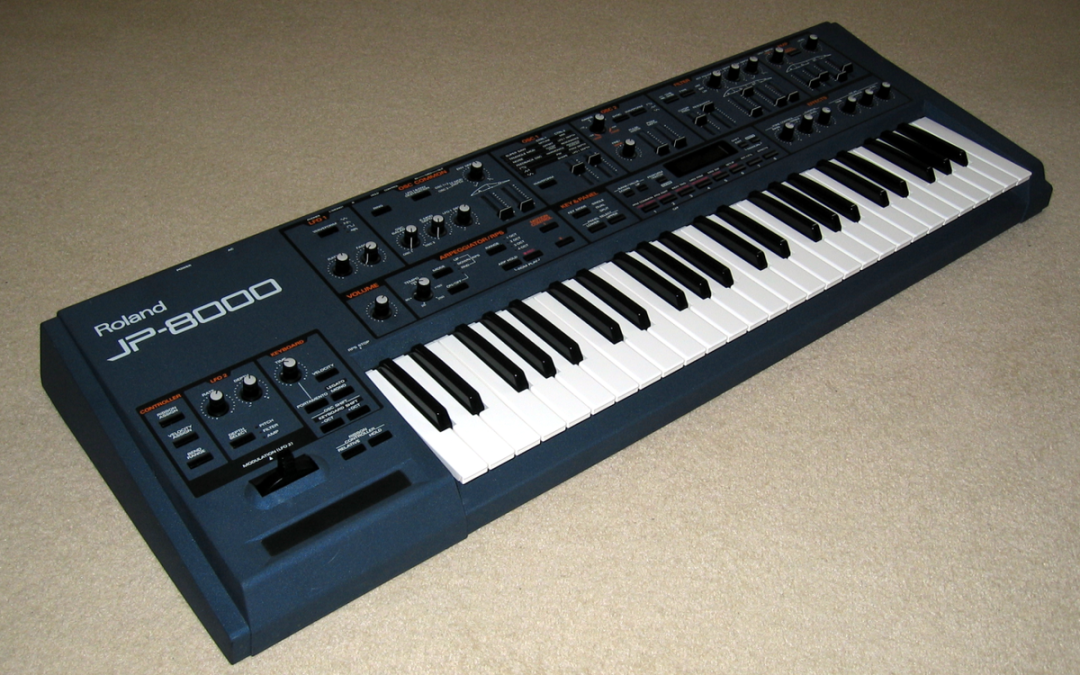The “supersaw” originated in the ’90s and had a surge of popularity in the early 2000s, featured heavily in genres like trance, future bass, and progressive house. The now-iconic sound is a staple of EDM production.
What Is Supersaw?
Supersaw is a style of waveform. It consists (as originally designed) of seven sawtooth oscillators all slightly detuned from one another. Characteristically, this style of synth sound has a sharp buzzing quality to it; however, it isn’t thin or anemic and typically sounds pretty huge—perfect as a pad or lead.
Check out a song like Rank 1’s “Airwave – Original Mix” from 1999—the supersaw sound is all over the place, prominently entering around the 3:17 mark and signaling a transition. About a minute later, it forms the backbone of the whole arrangement as a harmonically massive lead/pad.
It all began with the Roland JP-8000
Roland developed the supersaw waveform for their JP-8000 synthesizer in 1997. In that sense, the company single-handedly influenced electronic music for years to come.
While the JP-8000 is no longer in production, Roland continues to make other synthesizers that produce the waveform. And of course, there are plenty of soft synths that emulate it, or you can always recreate the style yourself with your favorite plugin synthesizer.
How Is the Supersaw Effect Created?
The most basic recipe for supersaw sound is multiple oscillators running saw waves and detuning them just enough to where you can begin to hear it. Dial up the number of unison voices on each oscillator for the sheer size that the supersaw synth sound is known for. Then you can experiment with high-pass filtering the oscillators individually to where you have a good balance of midrange aggression, high-end sizzle, and just a touch of low-end for size.
Experiment with touches of modulation like chorus and flanger to emphasize the effect, and call up some reverb to give it a space and depth. Your supersaw patch will turn out unique to your taste, but even just messing around with simple settings like this will get you in the ballpark.
Here’s a supersaw recipe for trance music using Reveal Sound’s popular Spire software synthesizer:
- Oscillator 1: saw wave; 9-voice unison; slight detune
- Oscillator 2: saw wave; 9-voice unison; slight detune; fine tune up
- Oscillator 3: saw wave; 9-voice unison; slight detune; fine tune down
- Oscillator 4: noise generator; high-pass to create white noise; pitch it up; blend to taste with Oscillators 1-3
- Filter: HPF just to remove some of the muddiness while retaining body and fullness
- Envelope: lower the sustain; fast decay time; adjust overall level to compensate for volume lost via sustain setting
- Distortion: to taste for some extra bite
- Reverb: to taste, but bigger, wet reverbs sound great on supersaw synths; cut some of the high-end so it doesn’t compete with the brightness of the sawtooth waves
Tips for Utilizing Supersaw Synth
The recipe above covers most of what you need to know about creating the supersaw sound. The following are key features to getting the most out of your synthesizer when emulating the sound yourself.
Use Multiple Oscillators
This is key. A four-oscillator synth works great, but even if you only have two, you can make do. One synth that comes to mind is u-he’s Hive. It only has two oscillators but includes 16-voice unison, so it still sounds huge. Just make sure the oscillators are pumping out sawtooth waves; if you follow the recipe above, you can include a noise oscillator too.
Harmonic Richness
The absolute core of the supersaw sound is its harmonic richness, which stems from slightly detuning the oscillators. Without getting too technical about sound perception, you can very slightly shift the fundamental frequency without our ears picking up a huge change in pitch. Of course, the overall result is this massive, harmonically rich timbre known as supersaw!
Use Effects to Make It Yours
Modulation like chorus or flanger is a cool way to enhance the whole sound as long as it doesn’t go too overboard.
Distortion/saturation is awesome for giving it some more texture and aggression, depending on context, of course.
Reverb sounds incredible on big synth sounds like these, so you can really put it in its own space within the arrangement. Your use of effects will shape the more unique characteristics of your individual supersaw sound.
Want to learn more about EDM production? Check out the course Producing Electronic Music with Matt Lange!
